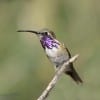 By Jim Stevenson
By Jim Stevenson
This Gallery deals with the more primitive land birds (non-songbirds) we saw out West. Hope you enjoy them! I would be remiss if I didn’t say what a wonderful group traveled with me in Alaska, and I was truly sorry to see them leave! Partly owing to them, we had a fantastic AK trip, really missing very few species we had hoped to see.
The fall photography workshop will be the last weekend (4 days) of September, with the top area being the Smith Point Hawkwatch Tower. The fall birding (extended) weekend will be the next week, right at the beginning of October. These are Thursday through Sunday events, but if there is any space left, we might allow people to just come for the weekend. NO REGISTRATION UNTIL LABOR DAY, but you can e-mail me if you like.
Record highs are all over Alaska and many building which never had A/C are just sweltering.
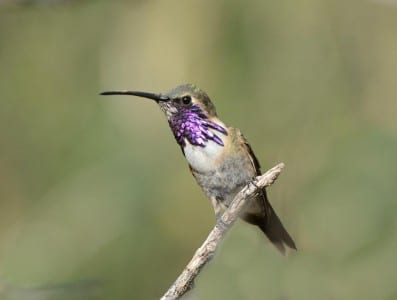
The Lucifer Hummingbird is one of the most sought-after hummers in North America. The shaggy purple throat and decurved bill on the males make them very conspicuous and they tend to live in drier areas than most other hummers. I find it interesting but completely unhelpful how the Underworld is used so often in names, like Devil’s Canyon, Perdition Bay, Hell’s Gate and so-forth.
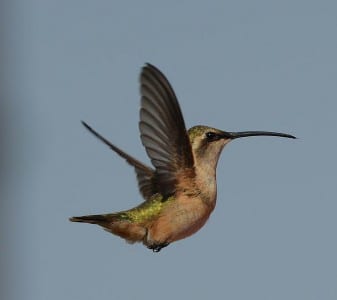
Female Lucifer’s Hummingbirds lack the gorget but certainly don’t miss out on the bill of the male! Also, having an eyestripe is a nice addition, as many female hummers have virtually nothing, making identification a challenge. Here you can see the long, narrow wings of a hummer, indicating their closest living relatives – swifts
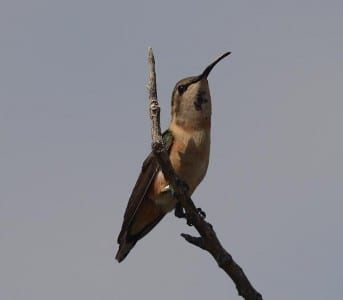
If you look closely at hummers you can often see that some presumptive females are actually immature males. Note the tiny purple flecks in this individual’s throat, just as many of you have seen small bits of red in female ruby-throats in the eastern half the country. The reason females seem to outnumber males of many species is the incidence of immatures (half of them males) looking like females. In a few birds, though, like frigatebirds*, immatures represent a third morph. *Like the white head
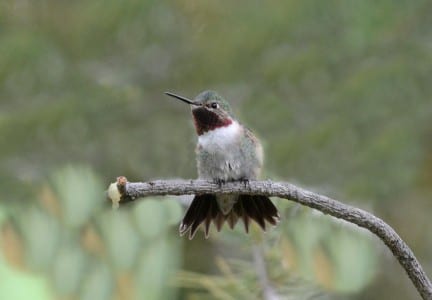
Up in the Rockies, Broad-tailed Hummingbirds thrive at the feeders of many. Looking a lot like the ruby-throats of the East, these buzz and whir around hummingbird feeders, often unchallenged by other species. Then the Rufous shows up… Isn’t it a curious thing how oftentimes the smaller the bird, the tamer it is? BTW, one reason why we should be careful about dropping the last name of birds is that many times there are other, often unrelated species whose name is the same, without the last word. There is a Ruby-throated Hummingbird, but also a (Siber ian) Rubythroat. The “ivory-bill” may mean one thing to you, but there’s also an Ivory-billed Woodcreeper (in the New World Tropics). And so-on."
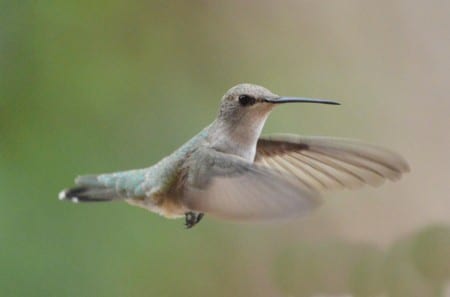
Female hummers are tough and often require several bits of information. Some are virtually indistinguishable. A few things that might help are the head and bill, the tail and is there (possibly) just one male it’s associating with? Also check the map for location, although seasons aren’t as important. In the Tropics, like Costa Rica, elevation is a good “field mark,” as habitat is often key with many species. Check out King & Clapper Rails.
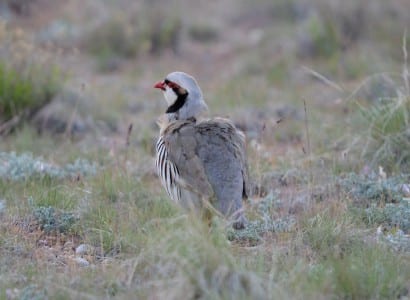
While it is patently illegal for US citizens to introduce game birds into the Country (or any other species for that matter), the Government historically has felt it had the right to bring in Asian species at will. After all, they work for the hunter/fisherman lobby. But enough ranting; this is the Chukar, a quail- like bird of western states like Utah. They are particularly common on Antelope Island in the Great Salt Lake, where the virtual absence of predators has been a boon to their species.
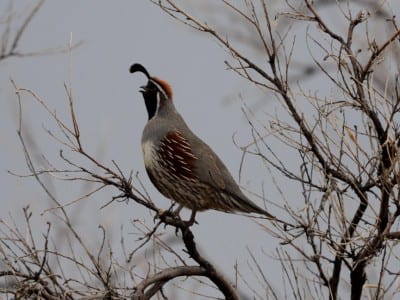
The American West is actually full of galliforms, from these Gambel’s Quail to robust grouse. The above, and other quail out West, have stick-like topknots to imitate limbs as they mosey through underbrush and sit atop limbs. Males of many species that lives in open areas use natural or artificial structures to sing from, as it gets the word out more.
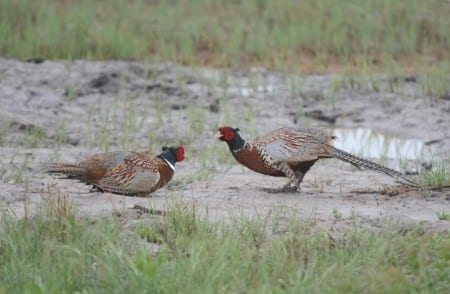
These two male “ring-necks” (see the problem?) are locked in heated territorial dispute, with hens not far away. Many male birds have given up a lot to wear bright feathers, all in an evolutionary struggle to pass on their genes. Nowhere is this more true than with several species of pheasants. But while they certainly lack camouflage, they *do* have the white ring around the neck that serves as a ruptive mark, breaking up the form of the bird. Many species of yummy birds (like ducks) have colors which separate the head from the body, so it doesn’t happen physically!
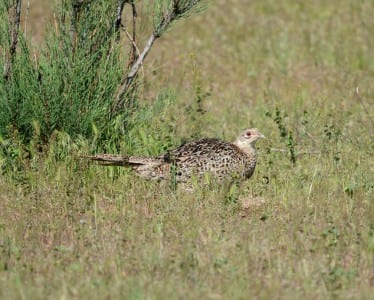
While male pheasants are stunning, females have as good camouflage as hen ducks. They are the ones who lead both the female and male’s progeny around, and with the enemies they have, every bit of aid is appreciated. Also, if danger comes, females take off like a rocket and the chicks flatten out on the ground, equally camouflaged.
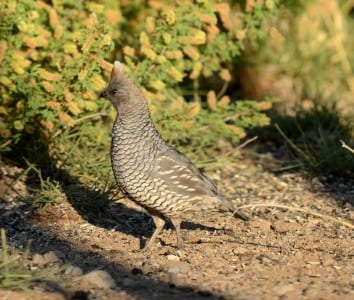
In drier areas, Scaled Quail walk through rough and thorny scrub with their cotton tops on display. Obviously, the grayer color works better for life in the desert, and camouflage tops ruptive marks in this species. I have always found it an interesting study how various avian species develop different color adaptations, such as these previous two, or mimicry, countershading, cryptic coloration or whatever.
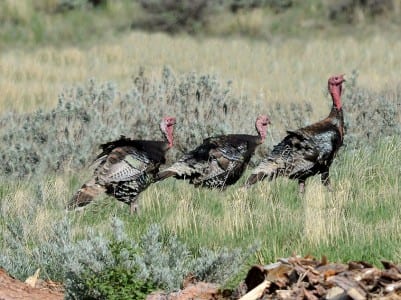
Our largest galliform is the Wild Turkey (there are other turkeys elsewhere) and they have different races around the Country (some of you fellow Texans know the Rio Grande race). This is one of those species that plays an important role in who we are, although some turkeys give more thanks for that than others. But despite the President sparing only one turkey at Thanksgiving, this magnificent species has recovered in a big way over much of the Lower 48.
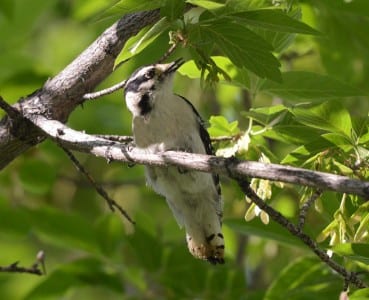
Woodpeckers are familiar to all of us, hammering in our yards (OK, rare on Galveston!) and leaving nesting holes en perpetuity (these are often used by other species at a later date, like small owls). This Downy Woodpecker shows some of the typical woodpecker adaptations, like long toes, a chisel bill and stiff tail feathers. The larger Hairy Wdpkr has white outer tail feathers without the black markings, and a much longer bill.
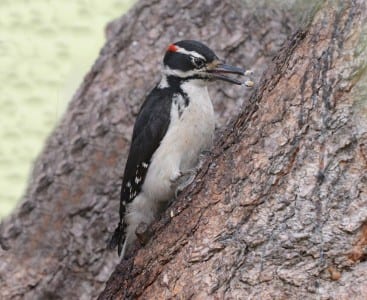
Hairy Woodpeckers are common out in western mountains, while they are uncommon in most areas back East. These western birds are blacker on the back, perhaps bringing up visions of three-toed woodpeckers. Here you can see the long, strong toes of birds in this family, with two in the front and two behind (zygodactyl).
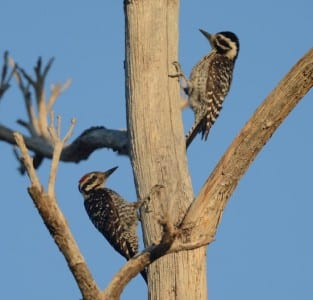
In the Desert Southwest the Ladder-backed Woodpeckers joins the Golden-fronted in dry scrub and cactus. They sound much like the Downy but are larger, and have other minor differences. Those of us in the Houston/Galveston area should be on the watch for these: I’ve had one (briefly) and another one seems to live at Laffite’s Cove. Is it possible it may be breeding with a Downy!
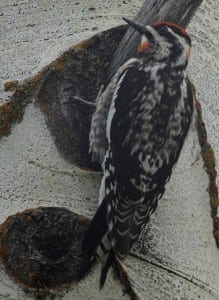
Sapsuckers are several species of woodpeckers that peck on trees and take the sap, plus any insects that get stuck to the concoction. The one in the East in the Yellow-bellied, but above is the Red-naped Sapsucker, a common bird of the Rocky Mtns. Similar, huh!
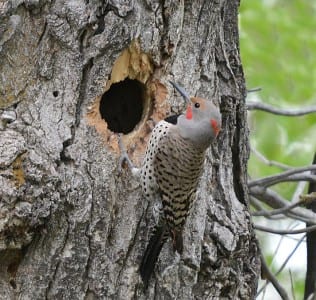
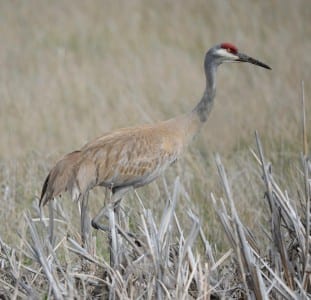
Many people think herons & egrets are cranes, but these fine birds are far more terrestrial than those waders, and even in a separate order (with rails). Their bill is round, not like the heron’s dagger, and they possess a bustle which (I believe) protrudes from their lower back. Sandhill Cranes are game birds but hopefully will be spared on Galveston Island.
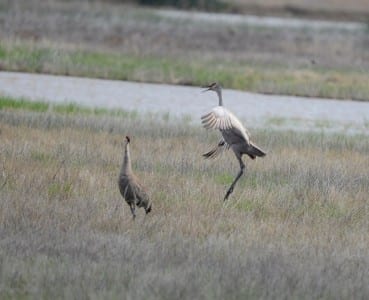
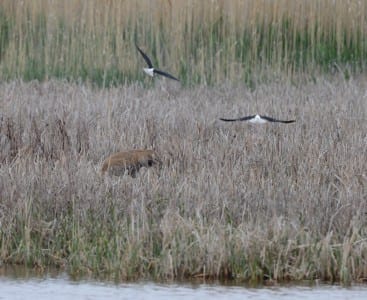
Cranes out West or in Alaska are often stained with tannin, though rarely on the Upper Texas Coast. I have also heard different hypotheses and wonder what the whole story is. Here one has robbed a stilt nest and is oblivious to the screaming parents. Nature is not always a gentle thing.
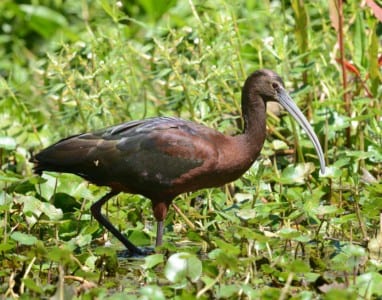
White-faced Ibis are all over the West and Glossy Ibis are circumequatorial ( including the SE US), and this bird may well be a hybrid between those two species. The eyes are red but dark and the white face doesn’t quite reach around behind the eye. These are two very closely related species which have mated before. The larger question might be if this bird is fertile or sterile. OK folks, that’s a wrap

 Posted in
Posted in 

























Great Photo’s and Great Education–
I love your pictures and comments. Birds of any kind make me happy.